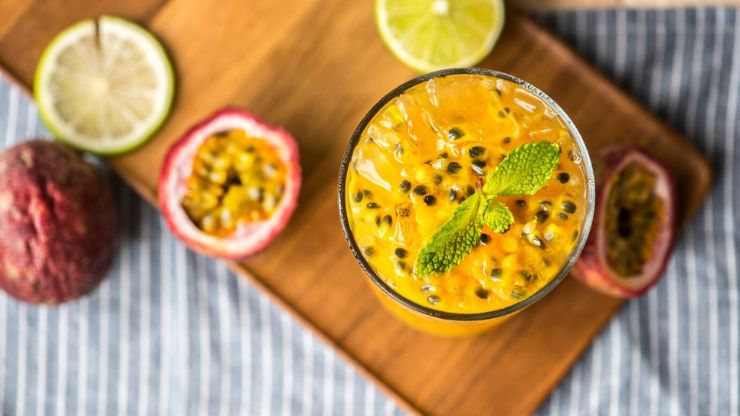Pineapple turmeric sauerkraut is a delicious fusion of flavors that elevates traditional sauerkraut to new heights. Combining the natural tanginess of cabbage fermentation with the tropical sweetness of pineapple and the warm, earthy notes of turmeric, this unique condiment offers a burst of flavor and a myriad of potential health benefits.
Whether you’re an experienced sauerkraut enthusiast or a beginner looking to explore the world of fermentation, this recipe promises a delightful and nutritious journey. In this outline, we’ll take you step by step through the process of crafting your own homemade pineapple turmeric sauerkraut.
Get ready to tantalize your taste buds and discover the joys of creating this vibrant, probiotic-rich dish in the comfort of your kitchen.
Table of Contents
ToggleAbout Sauerkraut
Sauerkraut is a traditional fermented cabbage dish that originates from Eastern Europe and is a staple in many cultures. It’s made by thinly slicing or shredding cabbage and then fermenting it through a natural process involving lactic acid bacteria. During fermentation, these beneficial bacteria break down the sugars in the cabbage, turning them into lactic acid. This process not only preserves the cabbage but also imparts a tangy flavor and transforms it into a probiotic-rich food.
Also, Read – Guilt-Free Veggie Breakfasts
Health Benefits Of Sauerkraut
Here are some of the health benefits of sauerkraut:
- Probiotic Power: Sauerkraut is teeming with live probiotic cultures, such as Lactobacillus, which promote a healthy balance of gut bacteria. Consuming probiotics can support digestion, boost the immune system, and enhance overall gut health.
- Rich in Vitamins and Minerals: Sauerkraut is a good source of essential vitamins like C, K, and B vitamins, as well as minerals like calcium, magnesium, and iron. These nutrients contribute to immune function and overall well-being.
- Improved Digestion: The probiotics in sauerkraut can aid in the digestion of complex foods, making it easier for the body to absorb nutrients. It may also reduce symptoms of indigestion and bloating.
- Antioxidant Properties: Fermentation increases the antioxidant content of sauerkraut, which can help neutralize harmful free radicals in the body, potentially reducing the risk of chronic diseases.
- Enhanced Immunity: A significant portion of our immune system resides in the gut, and the probiotics in sauerkraut can help strengthen the body’s natural defenses against infections and illnesses.
- Potential Mental Health Benefits: Emerging research suggests a link between gut health and mental well-being. Consuming probiotic-rich foods like sauerkraut may have a positive impact on mood and mental health.
- Weight Management: Some studies have indicated that maintaining a healthy gut microbiome through probiotics, like those found in sauerkraut, may play a role in weight management and obesity prevention.
Ingredients
To make pineapple turmeric sauerkraut, you will need the following ingredients:
- Cabbage: 1 medium-sized head of green or red cabbage, finely shredded.
- Pineapple: 1 small, fresh pineapple, peeled, cored, and chopped into small pieces.
- Turmeric: 2-3 tablespoons of freshly grated or powdered turmeric, depending on your taste preferences.
- Salt: 2-3 tablespoons of non-iodized salt, such as sea salt or kosher salt. The exact amount may vary depending on personal taste and cabbage weight.
- Optional Ingredients:
- Ginger: A 1-2 inch piece of fresh ginger, grated or sliced, for added flavor.
- Garlic: 2-3 cloves of garlic, minced or sliced.
- Black Pepper: A pinch of freshly ground black pepper for a slight kick.
Please note that these quantities can be adjusted to suit your taste preferences. You can also experiment with other optional ingredients to personalize your pineapple turmeric sauerkraut.
Also, Read – Best Breakfast Choices to Lower Blood Sugar
Preparation

To prepare pineapple turmeric sauerkraut, follow these steps:
Preparation Time: 30-40 minutes
Fermentation Time: 1-2 weeks
Equipment:
- Glass fermentation jar
- Knife
- Cutting board
- Mixing bowl
- Weight (to keep the ingredients submerged)
- Airlock system or a loose lid for the jar
Instructions:
Don't just scroll, subscribe!
BuzzTrail's unique web-stories are the cure for boredom you've been waiting for.
Sterilize Your Equipment:
- Clean and sterilize your glass fermentation jar, knife, cutting board, mixing bowl, and any other utensils you’ll be using. It’s important to maintain a sterile environment for the fermentation process.
Prepare the Cabbage and Pineapple:
- Remove the outer leaves of the cabbage and set them aside. These will be used later.
- Slice the cabbage thinly, discarding the core.
- Peel and core the pineapple, then chop it into small pieces.
Prepare Optional Ingredients:
- If using ginger, garlic, and black pepper, prepare them by grating or slicing as per your preference.
Mix the Ingredients:
- In a large mixing bowl, combine the shredded cabbage, chopped pineapple, turmeric, and optional ingredients (ginger, garlic, black pepper).
- Sprinkle the salt evenly over the mixture.
Massage and Macerate:
- With clean hands, massage and squeeze the cabbage mixture for about 5-10 minutes. This helps release moisture from the cabbage and combine the ingredients.
Rest and Allow Maceration:
- Let the cabbage mixture sit for about 15-20 minutes. During this time, the salt will draw more moisture from the ingredients.
Pack the Jar:
- Begin packing the cabbage mixture into the sterilized glass fermentation jar.
- Pack it tightly, pushing it down to remove any air gaps. You want the mixture to be submerged in its own juices.
- Pour any remaining liquid from the mixing bowl into the jar.
Fermentation Setup:
- Place one of the reserved cabbage leaves over the mixture in the jar. This acts as a barrier to keep the ingredients submerged.
- Place a weight (e.g., a smaller jar filled with water) on top of the cabbage leaf to hold everything down.
- Attach an airlock system to the jar or cover it with a lid, but leave it slightly loose to allow gas to escape during fermentation.
Fermentation:
- Store the jar in a cool, dark place for 1-2 weeks, or until it reaches your desired level of fermentation. Check the sauerkraut every few days to ensure it remains submerged and no mold forms on the surface.
Taste Testing:
- After a week, start tasting the sauerkraut to gauge the level of fermentation. When it reaches your preferred taste, move it to the refrigerator to slow down the fermentation process.
Serving and Storage:
- Serve your pineapple turmeric sauerkraut as a side dish, condiment, or ingredient in various recipes.
- Store any remaining sauerkraut in the refrigerator for several months.
Enjoy your homemade pineapple turmeric sauerkraut!
Conclusion
In conclusion, creating your own pineapple turmeric sauerkraut is a rewarding culinary adventure that blends the bold flavors of pineapple and turmeric with the traditional art of fermentation. Not only does it provide a burst of unique taste, but it also offers an array of health benefits, thanks to its probiotic-rich nature.
Whether you’re seeking a probiotic boost or a delicious addition to your meals, this homemade sauerkraut is a testament to the wonderful world of fermentation. Get ready to savor the delightful tang and explore the endless possibilities this vibrant condiment can bring to your kitchen.
FAQs
What is pineapple turmeric sauerkraut?
What is pineapple turmeric sauerkraut?
Pineapple turmeric sauerkraut is a unique variation of traditional sauerkraut that combines the flavors of fermented cabbage with the tropical sweetness of pineapple and the warm, earthy notes of turmeric.
What are the health benefits of pineapple turmeric sauerkraut?
What are the health benefits of pineapple turmeric sauerkraut?
Pineapple turmeric sauerkraut provides the probiotic benefits of traditional sauerkraut along with the potential anti-inflammatory and antioxidant properties of turmeric. It can support gut health, digestion, and overall well-being.
Is it necessary to use fresh pineapple, or can I use canned pineapple?
Is it necessary to use fresh pineapple, or can I use canned pineapple?
While fresh pineapple is preferred for its natural sweetness and flavor, you can use canned pineapple in a pinch. Just be sure it’s packed in its own juice without added sugars or preservatives.

